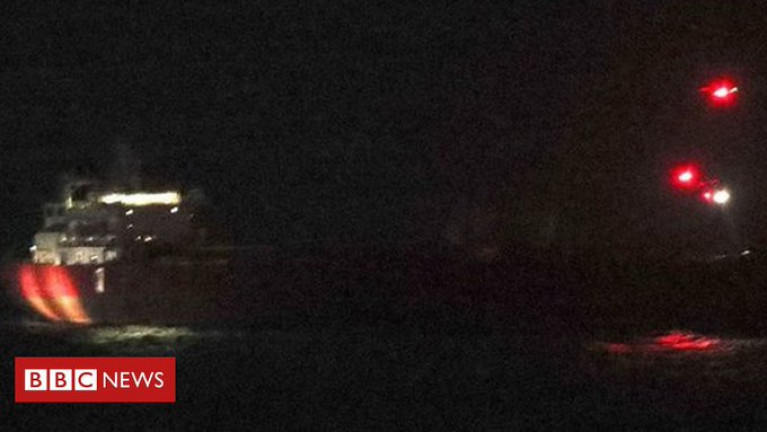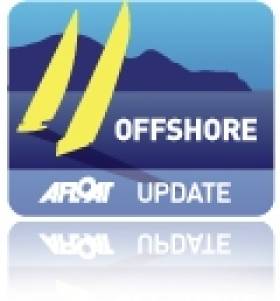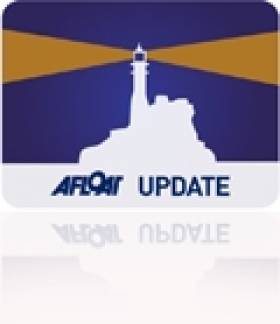Displaying items by tag: Isle of wight
The Volvo 70 Tschuss 2, skippered by Johnny Mordaunt and with a large Irish crew onboard, has broken the Round Isle Of Wight sailing record with a corrected time of six hours, 22 minutes, and 25 seconds.
Wednesday's record bid was completed in an elapsed time: 03 hours, 55 minutes, and 55 seconds.
Owner Christian Zugel was on board, along with crew members Chris Welch, Nin O’Leary, Stu Bannatyne, Neal MacDonald, Cian Guilfoyle, Freddy Shanks, Al Fraser, Alex Higby, Tristan Seal, Simon Johnson, Stefano Nava, Campbell Field, and Jack Lawrence.
UK military forces stormed a tanker suspected to have been hijacked off the Isle of Wight which led to seven people detained.
Sixteen members of the Special Boat Service (SBS) ended a 10-hour standoff which started when stowaways on board the Liberian-registered Nave Andromeda reportedly became violent.
The stowaways, believed to be Nigerians seeking UK asylum, were handed over to Hampshire Police on Sunday night.
The 22 crew members were found safe.
The ship later docked in Southampton.
BBC defence correspondent Jonathan Beale said British forces descended on to the vessel by rope from four Royal Navy helicopters after nightfall.
"The seven stowaways - believed to be Nigerians seeking asylum in the UK - were detained and handed over to Hampshire Police," he said.
Navios Tanker Management, operator of the crude oil tanker, said the master of the vessel became concerned for the safety of the crew "due to the increasingly hostile behaviour of the stowaways" who had "illegally boarded" in Lagos, Nigeria.
In a statement released on Monday, the company thanked the UK authorities for their "timely and professional response".
More on the English Channel incident here.
Isle of White Operator Marks First Year of Hi-Speed Craft Red Jet 7 In Advance of Cowes Week
Afloat has followed the launch of an Irish Sea shipyard built freight ferry Red Kestrel onto an Isle of Wight service for Red Funnel which also operates Hi-Speed passenger catamaran, Red Jet 7 which today marked one-year of service on the Solent.
According to Red Funnel the craft has travelled over 84,000 nautical miles, completed 3,615 round trips and nearly half a million passenger journeys.
Red Jet 7 joined the Isle of White serving fleet on July 17, 2018, and like elder fleetmate, Red Jet 6, was built on the English Channel island by Wight Shipyard Co. representing a £7m investment by Red Funnel.
To date Red Jet 7 has spent almost 3,000 hours at sea since launching last year following a prestigious naming ceremony by the Duchess of Cornwall who officially named the new ferry with the traditional formality of breaking a bottle of champagne on the bow.
The craft is the greenest ferry within the Red Jet group as it utilises a new technology to reduce an environmental footprint, and at four tons lighter than Red Jet 6, has improved fuel consumption which further reduces emissions.
Commenting on the one-year anniversary, Red Funnel CEO, Fran Collins, said: “The launch of Red Jet 7 was another proud day in Red Funnel’s history. We take great pride in our commitment to supporting British shipbuilding and are particularly proud of the fact that she was built on the Island, for the Island, utilising the skills of more than 85 Island-based expert craftsmen.
“In her first 12 months of operation, Red Jet 7 has a earned reliability score of 99 per cent and a punctuality score of 93 per cent, meaning that 99 per cent of all our scheduled crossings went ahead as planned and 93 per cent of crossings departed and arrived on time, with the majority of the shortfall due to adverse weather conditions such as fog and strong winds.
The CEO added "Overall, she’s had a very successful first year and we look forward to many more, especially as we now head into our summer season and concurrently mark another big anniversary – 50 years of hi-speed service, which we’re marking with The Red Funnel Fireworks at Cowes Week on the 16th of August. We can’t wait!”
#ferries - It was a new direction for long-established British ferry company, Red Funnel Ferries, the original Isle of Wight ferry operator, as today they welcomed their first ever-ro-ro freight ferry with a traditional ship naming ceremony.
Following 14 months in development, Red Kestrel, has become the newest addition to Red Funnel's fleet. The newbuild will also be the first dedicated Ro-Ro freight ship since the company’s inception almost 160 years ago.
The Great British-themed naming ceremony, which celebrated Red Kestrel being built in the UK, took place in Southampton docks by the Ocean Terminal and was witnessed by some 200 invited guests. Karen George, wife of Red Funnel’s Chairman, Kevin George, had the honour of christening Red Kestrel, with the traditional formality of breaking a bottle of champagne across the stern of the vessel.
Karen was accompanied by the Rt Hon Alok Sharma MP, Minister of State for Employment at Department of Work and Pensions, who also shared a speech highlighting the importance of British craftmanship, supporting local jobs and the revival of world-class shipbuilding in this country.
Opting for the build of the ship to be based within the UK, Red Funnel awarded the contract to the famous British shipbuilding company, Cammell Laird, based on the River Mersey at Birkenhead. In total, the project used 45 British supply chain businesses and generated 3,000-man hours of work for Cammell Laird's apprentices.
Commenting on the naming ceremony, Fran Collins, CEO of Red Funnel, said, “Today has marked a very special occasion in the history of Red Funnel. The addition of a new ship is always an exciting time for everyone, and Red Kestrel marks an important new direction for us as our first-ever freight ship.
“With the growth in the Isle of Wight economy over recent years, we had reached a point where we could no longer fulfil the growing demand. Following extensive research, we identified that to increase capacity on our passenger vessels, we would need a dedicated freight ferry to assist with the freight side of the business.
“Red Kestrel is designed to provide additional year-round freight capacity for our Southampton to East Cowes route, which currently handles 53% of all freight movements across the Solent.
“Our investment marks a vote of confidence that the UK and Isle of Wight economies are going to continue to grow and we can support this growth with the additional sailings Red Kestrel will provide.”
Tony Graham, Cammell Laird’s Chief Operating Officer, added: “Cammell Laird would like to thank Red Funnel for placing its trust in us to build this wonderful state-of-the-art ferry. Completing this ship sends a very strong message to the global maritime industry about Cammell Laird’s ferry building capabilities after we won the contract against international competition.
“Shipbuilding is back in a serious way on the Mersey and it has been brilliant to see the Red Kestrel being built alongside the iconic RRS Sir David Attenborough, which is the largest commercial vessel built in Britain for a generation We are proud to see the Red Kestrel join a collection of ferries that Cammell Laird has built in recent years.”
Red Kestrel will operate between Southampton and the Isle of Wight and will officially enter service in May. As a freight vessel, she is limited to 12 passengers and constructed specifically to provide additional year-round freight capacity for Red Funnel’s Southampton to East Cowes route.
At 74m in length, she will provide 265 lane metres of roll-on/roll-off freight capacity, allowing for 12 HGVs. To minimise the environmental footprint, the hull shape has been designed specifically to reduce wash and a propulsion package has been selected to make her highly fuel efficient.
The use of proven azimuth thrusters supplied by Rolls Royce will also make the ship very manoeuvrable. Her dedicated drivers-only lounge offers comforts and features such as access to hot/cold food, reclining leather seats with foot rests, free Wi-Fi and ample charging points.
Red Kestrel will use the same berths as Red Funnel’s existing Raptor class ro-pax vehicle ferries in Southampton and East Cowes.
#RTIR - Winning tactical advice from some well-known names and faces associated with the Round the Island Race has been posted online ahead of the latest edition of the iconic annual event at the Isle of Wight.
Later today (31 May) will also see the official pre-race press conference on the eve of the 2013 JP Morgan Asset Management Round the Island Race, the 82nd anniversary of one of the most prestigious events on the world sailing calendar.
A terrific line-up of guests including Dame Ellen MacArthur and Alex Thomson will be on hand for the presser, which will be streamed live online and will also feature a tribute to the late Andrew 'Bart' Simpson, whose memorial service and private funeral is also being held today. The Island Sailing Club will fly the ensign at half-mast this afternoon.
Later this evening, the race competitors will meet for the all-important weather briefing. Racers will be given the latest weather and tidal information luve, coboned with tactical advice from Met Office-trained professional meteorologist Chris Tibbs.
In addition, competitors can evaulate the weather prior to the race by viewing the course overview and tidal strategy videos at the Raymarine website.
Among this year's competitors are Yvonne Margerison and her long-term partner Mike Flint, who are racing in their 20th Round the Island Race.
The couple entered their first back in 1993 in their boat Charis and have taken part almost every year since, apart from one when their mast was broken awaiting repair, and another when they sold Charis and were waiting to buy their new boat Gernee (S31) which is entered this year.
Margerison and Flint are passionate about sailing, have been very active members at Rutland Sailing Club - Flint is a past commodore - and both are former commodores at the Newparks Cruising Association Club.
While there's been talk of their retirement from racing - let's hope that won't be till after tomorrow's race, where race organisers hope they'll put in a strong showing.
How to follow the Round The Island Race action
The action begins tomorrow morning 1 June at 5am, and spectators can keep fully up to speed on the racing as it unfolds via the official Round the Island Race website, with features from the live blog to live race tracking, weather updates, and the latest news and results.
The race Facebook page and Twitter feed will also be maintained with the latest happenings. For those wishing to contribute to the Twitter news as the racers sail around the island, use the hashtags #RTIR and/or #RaceForAll to raise another £1 for the official charity, The Ellen MacArthur Cancer Trust.
Fastnet Race Limit Increased
The Rolex Fastnet Race reached its entry limit 10 days after opening and over 130 boats are on the waiting list. "We were staggered at the speed with which people signed up," said RORC Commodore Andrew McIrvine. "We had to do something to satisfy the huge interest, and taking the non IRC yachts out of the total is a fair solution allowing more loyal RORC racers to get their boats into the race."
Removing the non-IRC classes will add about 50 more places to the total. "We are delighted that the Volvo's and IMOCA's want to compete in the race and that the Class 40's are coming en-masse," said RORC Chief Executive, Eddie Warden Owen. "It shows the popularity of the Rolex Fastnet that these professionally sailed boats want to join the race. However without this initiative, they would be taking valuable places away from less experienced offshore racers who view this race as a great personal challenge - their 'Everest' of sailing."
Sutton Harbour increase berthing capacity
To cater for the number of boats arriving in Plymouth, Sutton Harbour Marina has increased the amount of space by making the whole of the berthing area adjacent to West Pier and the Barbican available to the Rolex Fastnet fleet. Sutton Harbour has also become the official berth provider for the race and Chief Executive Nigel Godfroy is pleased to be associated with the race. "Sutton Harbour Marina welcomes the return of this world famous race," said Nigel. "We are very proud of the quality of facilities we have here in Sutton Harbour and being selected as the official berthing provider for the Rolex Fastnet Race. We look forward to welcoming the extra large fleet in August this year."
To accommodate the increased number of entries, space has been booked in Queen Anne's Battery, adjacent to Sutton Harbour and in Plymouth Yacht Haven in the Cattewater, where a water taxi service will be set up to connect competitors with the race office based at Sutton Harbour.
The 2011 Rolex Fastnet Race starts in Cowes, Isle of Wight on Sunday 14 August.
Haughey Yacht 'Celtic Mist' is For Sale
The 52 footer that has a cruising speed of 6 knots has been put up for sale by the family of the former Taoiseach with an asking price of €175,000.The boat is lying on the Isle of Wight.
The full details and photos from the broker are HERE.
The sale has created considerable media interest. Examples HERE and HERE.
Update: Ireland Consolidates Lead in Isle of Wight Race
The race on Friday, 20 August, has been a short offshore, although never out of sight of land, of 55 nautical miles. Of the three Irish yachts, according to the fleet GPS tracker, Antix leads her class, while Marinerscove.ie lies fourth and Roxy 6 eighth. Maybe not the best performance of this fantastic week for Irish sailing, but with the Hong Kong team struggling to capitalise, the Irish Cruiser Racer Association (ICRA) team led by Barry Rose may well end the day having extended its lead.
Saturday sees the final race of the series. It is a double-points race so anything remains conceivably possible. However, if the current standings translate into results, Ireland has a vice-like grip on the title, according to local sources including leading website Cowes online.
More as we have it.



























































